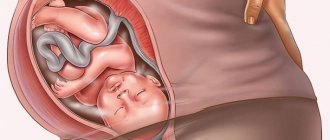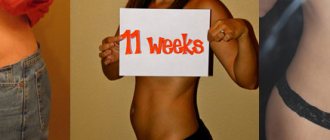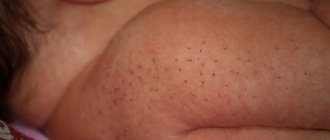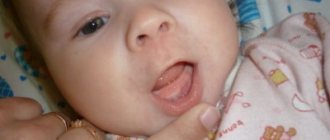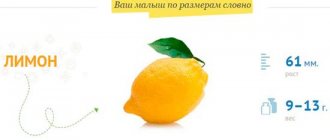All parents need to know what allergies look like in their child. This disease is widespread among children of the early age group. The causes of the disease are hereditary in nature or hidden in the environment of the baby. The disease occurs in mild, moderate or severe form and goes away without a trace with proper treatment.
Appearance of a newborn
Of course, your baby is the best and most beautiful baby in the world. Still, it would be useful to find out in advance about some possible features of a healthy full-term baby.
Head
Compared to the body, it looks disproportionate and large. The somewhat elongated shape is due to the fact that the bones of the skull and the sutures connecting them are movable. This is how Nature provides: when the mother passes through the birth canal, the bones of the skull shift relative to each other, which facilitates the birth process.
The changes do not affect the baby’s abilities in any way. Usually, after a few days, the moving bones take the correct position and the head acquires a rounded shape.
Birth tumor and cephalohematoma
a birth tumor occurs - the result of swelling of the soft tissues of the presenting part of the body (during childbirth, it is the first to be born). If the baby was lying head down in the uterus (with a cephalic presentation), it occurs on the head; in a breech presentation, it occurs on the buttocks.
Less commonly, a cephalohematoma is formed: when the head is compressed during childbirth, the vessels between the periosteum (fits the bone) and the outer surface of the cranial bones are damaged - hemorrhage occurs.
Usually, after a few days, the birth tumor disappears on its own. The cephalohematoma resolves within a few weeks; if it is large, it is punctured in the first days of life (the accumulated blood is removed with a syringe and a thick needle).
Feeding and sleeping
Food and sleep are the two most important things for a newborn. It is best to breastfeed your baby - it is more convenient for the mother and healthier for the baby. You need to feed your baby “on demand,” that is, when he asks. Routine feeding - every 3 hours - is a relic of the past. As a rule, after some time, children themselves establish a feeding regime that is convenient for them (but not strict!). For example, they start eating every 2 hours. This is the regime that parents must follow.
At night, the baby also feeds on demand, so it is not advisable to immediately allocate a separate room for him - the mother will have to run back and forth several times a night. Many parents move the crib close to theirs or place the baby with them.
In the intervals between feedings, the baby most often sleeps. In the first month, children sleep 14-19 hours a day. With each month, the periods of wakefulness increase, and by six months the child sleeps 13-14 hours a day. Moreover, if in the first months the baby can wake up every 1.5-4 hours, regardless of whether it is night or day, then from about eight months many children can already recognize the time of day and sleep from 10 pm to 6 am. And during the day they sleep 2 times for 2 hours. By the age of 1-1.5 years, the baby begins to sleep “like an adult” - all night and once during the day, after lunch.
whether to swaddle his child while he sleeps. Many people swaddle their children so that they do not wake themselves up with their movements; some children sleep more comfortably this way. Now most doctors believe that a child should have free arms and legs, as this is necessary for normal psychomotor development. Therefore, starting from the second month, it is better to wear rompers for your baby.
First day after birth. Is it really all over?
What happens to a woman immediately after giving birth? What does a newborn actually look like? What will happen in the maternity hospital on the very first day of your new life.
Read more
fontanelles
They are non-ossified areas between the bones of the skull - small depressions that you find when stroking the baby’s head.
diamond-shaped fontanel When you put your fingers on it, you may feel a slight pulsation - this is normal. A bulging or tense large fontanelle is an alarming sign and requires contacting a doctor.
The small fontanelle has a triangular shape and is located in the occipital region - the junction of the parietal bones with the occipital bone.
Usually the large fontanel closes at about the age of one year, the small one within a few months after birth.
Face
It bears the “imprint” of the colossal work that the baby had to do, making his way “to freedom.” Sometimes the face looks “bruised” with deep wrinkles. The palpebral fissures are often narrowed, the eyelids are swollen and swollen.
After a few days, the skin smooths out and the swelling goes away.
Eyes
They often “float”, move away in different directions or converge at the bridge of the nose, and the gaze does not linger for long on one object. At the same time, the child squints - this is the norm. The reason is weakness of the eye muscles. By three months, strabismus usually goes away, but in some babies it can persist until six months of age.
Red burst vessels may be visible on the whites of the eyeballs - hemorrhages that occurred during the passage of the baby through the mother’s birth canal.
Looking at the color of the eyes , adults wonder: are the eyes of mother’s or father’s, grandmother’s or grandfather’s? It's hard to say. At birth, the baby's eyes are usually bluish-gray, but may initially be brown. The final eye color is established around the age of six months or closer to a year.
Walks
You need to walk a lot with your child. You can start walking from the 10th day of a baby’s life, and the air temperature outside should not be lower than -10 degrees. The first walk usually lasts 10 minutes, and each subsequent walk is increased by 5 minutes. Ideally, you should walk for 1.5 - 2 hours 2-3 times a day, in any weather, avoiding too hot and too frosty. In cold weather, this hardens the child, and in warm and sunny weather it contributes to the formation of vitamin D in the baby’s body, which prevents the development of rickets. It is not recommended to leave the stroller with the child in direct sunlight.
Naturally, at first a small child only sleeps during a walk. Many mothers don’t want to spend all day wandering the streets with a stroller when there are a lot of household chores waiting for them at home. Therefore, in the first months, an excellent solution may be for the child to sleep on the balcony (though not all children agree to sleep in a stationary stroller). Later, the baby will begin to be more actively interested in the world around him, learn to sit down, and you will have to walk “for real.”
Muscle tone and movement
Legs and arms are bent at an unnatural angle. The baby moves his limbs chaotically: he twists and bends absurdly. Gradually, as the baby grows up, it learns to coordinate its movements.
Muscle tone is slightly increased - this is absolutely normal. The child clenches his fists and shows his face to everyone. If you place your finger in the baby’s palm, you will immediately feel a strong “handshake” from your child. By about the fourth or fifth month, the slight natural hypertonicity disappears.
Newborn baby
At home, all relatives imagine exactly the angel at the moment they meet and are slightly disappointed when they see something similar to a frog - just as small and helpless. If we talk about the appearance of a newborn in the first seconds of life, then he does not at all look like the child in the picture, and many mothers, especially if this is their first birth, experience fear and slight bewilderment, because they think that something is wrong with their child. To initially prepare mothers, there is a school for young mothers, where a gynecologist will talk about this and much more and psychologically prepare them for an adequate reaction when they see their own child.
Skin
They depend on the characteristics of the baby, the due date and the general condition of the child at birth.
color may be pale, bluish, purple or pink. Sometimes blood vessels become visible.
of cheese-like lubricant on the skin , covering the entire body of the baby in the womb. There is especially a lot of it in skin folds and depressions: in the armpits, in the area of the external genitalia, etc. The lubricant is removed by medical workers in the delivery room, but some of it remains.
In most children (up to 70–80%), on the 3rd–4th day of life, the skin acquires a jaundiced tint— physiological jaundice of newborns. Do not worry. This condition does not pose any danger and gradually passes. The main thing is to take timely measures and follow medical recommendations.
Diapers and hygiene
One of the most pressing issues in child care remains the use of diapers. The debate about whether they are harmful or not continues to this day. The main argument of opponents of diapers is that boys who wore diapers as children may develop infertility. However, scientists believe that this is not the case. Modern “breathable” diapers are quite safe for both girls and boys.
Naturally, wet diapers need to be changed regularly. The maximum time for wearing a diaper is 4-6 hours. When changing a diaper, the baby’s bottom must be washed and anointed with a special “diaper rash” cream. From time to time, the diaper can be removed, leaving the baby to lie down or crawl with a bare bottom (although this is not necessary).
What does an allergy look like in a 2-year-old child?
At this age, the list of sources of allergens is significantly replenished and expanded. A negative reaction is caused by food, household dust, animal hair, pollen, detergents and hygiene products, and medications. Allergies in a 2-year-old child are characterized by the following symptoms:
- rashes on the skin in the form of red spots, rashes;
- disturbances in the digestive tract;
- respiratory problems – runny nose, wheezing, bronchospasms;
- difficulty swallowing, hacking cough, gag reflex;
- lacrimation, conjunctivitis, migraine, stuffy ears.
If the baby complains of a feeling of constriction in the throat, tongue immobility and dizziness, then there is a high probability of anaphylactic shock. This phenomenon is accompanied by fainting, loss of consciousness, pulmonary edema and other life-threatening consequences. In such cases, emergency medical care cannot be avoided.
Pregnancy by week - photos of the baby at different stages
Every expectant mother wants to know how the little person inside her develops and grows. With trepidation, she awaits the next ultrasound so that she can look into this mysterious world for at least 5 minutes and see what the restless baby is doing and what is his mood today? And if you manage to take a photo of the baby in the mother’s tummy, then such a photo will definitely take pride of place in the family album.
Want more information? Read our article today on the BeeWoman.ru website, and you will find out how rapidly the embryo changes, acquiring human traits, and what your baby has learned to do today.
How does conception occur?
For a new life to be born, an egg and a sperm must meet. Everyone knows this. But how this happens has long remained a mystery.
Swedish photographer Lennart Nilsson was able to lift the veil of secrecy. For 10 years, he filmed how the embryo develops from the moment of conception to birth. You can see his work below.
In 1965, Nilsson published a photo book, A Child is Born, which remains one of the best-selling.
After fertilization, the egg begins to actively fragment and is sent to the uterus. Over the next 40 weeks, your baby will go from a poppy seed to a rosy-cheeked newborn baby. Thanks to information from the site https://www.9months.ru, we were able to create for you a picture of his intrauterine life.
Approximately on the 8th day after conception, the egg, having freed itself from the shell, settles on the uterine mucosa and, using its villi, begins to penetrate into it. The implantation process has begun.
The cells of the embryo are in continuous division and form 3 germ layers, from the cells of each of them entire organs and systems will grow. The outer leaf will become skin, nails and hair. The middle leaf is the spine, skeleton, blood vessels, blood, lymph and internal organs. The inner leaf will form the epithelium of the digestive and respiratory systems, liver and pancreas.
A pregnant woman's belly will be noticeable only from 4-5 months of pregnancy, but fetal development begins from the first days of conception. Let's watch how a real miracle happens.
Up to 8 weeks, until most of the organs are formed, your baby will be called an embryo, and later - a fetus.
Life before birth - photographs of intrauterine development of the embryo
His tiny heart will start beating 18 days after conception. But you won’t be able to hear its rhythmic beating soon.
Around the same time, the gray matter of the brain is formed.
The first month of pregnancy is coming to an end, the baby is now no larger than a sesame seed (~ 3 mm), but its lungs, stomach, and liver are already developing.
Over the next couple of weeks, the baby gains significant length, and at the sixth week of pregnancy already looks like a small pea. He will begin to develop a face with slits for eyes and ears.
Here is your small bean, 16 mm long. During this period, the baby, who floats freely in her “microcosm,” develops arms and legs, develops a belly and chest, and develops a vestibular apparatus.
Its length now is just under an inch, little Thumbelina.
The baby begins to make the first movements in the mother’s belly, but it is still impossible to feel them. Only an obstetrician can hear the heartbeat of an unborn baby through a stethoscope. The “maturation” of the diaphragm will soon be completed, and it will take an active part in breathing. Instead of a “tail,” buttocks appear.
This week usually marks the first ultrasound of a pregnant woman. The baby's genitals are already visible, and in 95% of cases the doctor can tell you the gender of the baby.
Its length is 10 cm. It weighs about 70 g, like a tiny kitten at birth.
You can get a good look at the baby's face. Do you think he looks like his dad? The child actively blinks, opens his mouth and improves his grasping reflex.
Imagine that you are holding a potato in your hands. This is the length your baby is now (~ 14 cm with a weight of 190-200 grams).
By the 20th week of pregnancy, the fetus has grown to 25 cm and looks like a large banana. The fruit is already fully formed, and its thin skin is not so transparent.
During this period, a significant event occurs - the child will hear his mother - her heartbeat, breathing, voice (his ossified auditory ossicles are now capable of conducting sounds). The baby sucks his thumb and becomes more energetic.
Original feces - meconium - are formed in the intestines and the kidneys are started. The eyelids and eyelashes are clearly visible on the eyes.
Its length from crown to heels is 30 cm, weighs approximately 550-600 grams.
Over the next 3 weeks, the baby will gain about 5-6 cm and an average of 250 grams.
From the 28th week, the fetal lungs are ready to breathe normal air. All his organs are formed, now the baby has to actively grow and gain weight.
The baby knows how to cry and responds, most often with kicks :), to external sounds. His biorhythms are clearly visible: while awake, the child opens his eyes and closes them when he sleeps.
During this period, the tummy has already noticeably rounded, and many pregnant women are thinking about having a photo shoot. Are you ready for this? If you still have doubts, then our article and selection of photos are especially for you.
The weight of a baby is on average 2,500 kg. The length of the baby is 47 cm.
From this time on, the fetus is considered mature and ready for birth. He's looking forward to meeting you!
Polina Morozova, especially for https://beewoman.ru
Similar
Related articlespregnancy
Leave a message
Cancel reply







